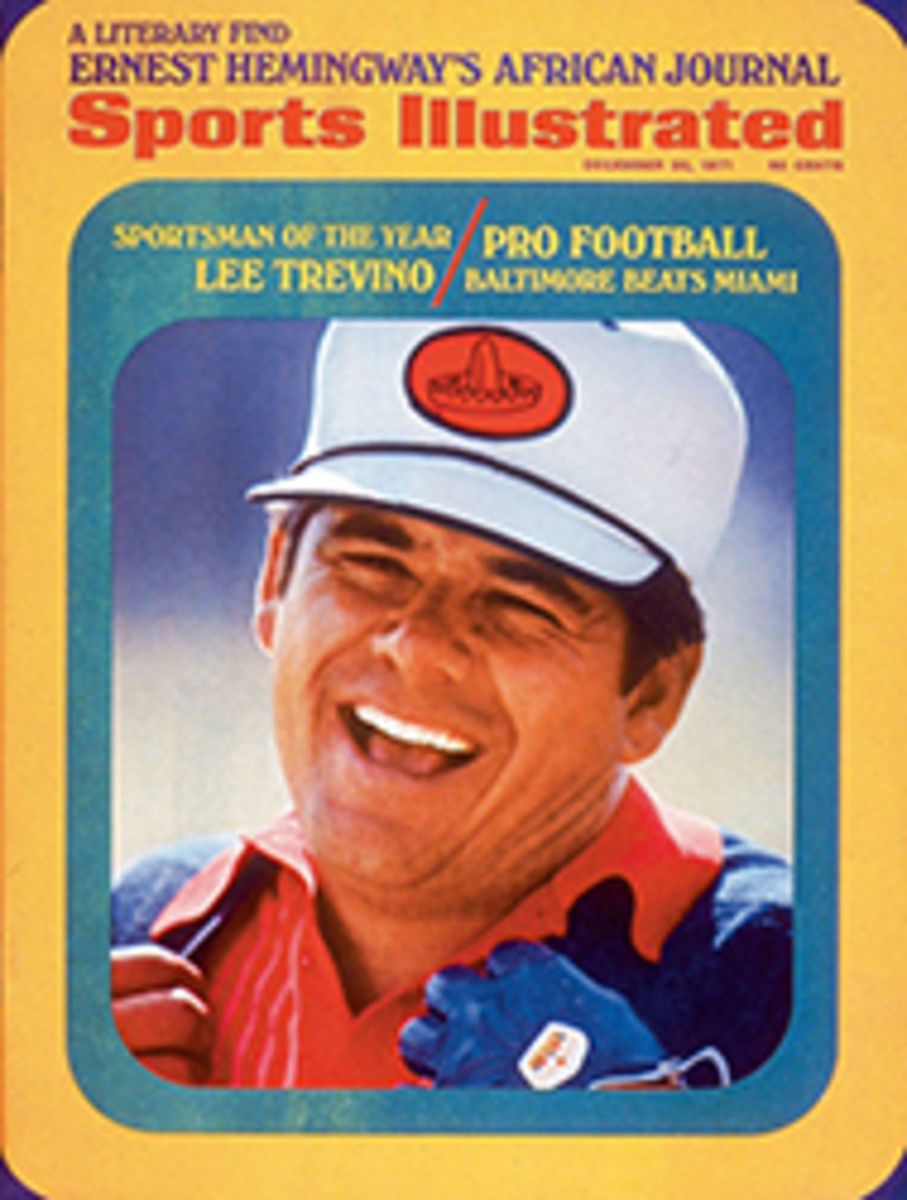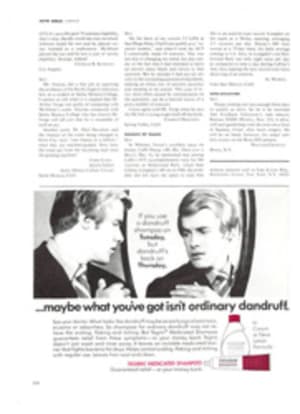
Introduction to An African Journal
When ErnestHemingway died in 1961 several unpublished manuscripts of consequence were leftin his estate. These included two novels, a few short stories and oneextraordinary work of nonfiction, African Journal, excerpts of which begin onthe following pages and will continue in two successive issues of SPORTSILLUSTRATED. The manuscript is immense by Hemingway standards—200,000 words—andrepresents some 16 months of his writing time between 1954 and 1956, though hewas often interrupted, most notably in October 1954 when he won the Nobel Prizefor Literature. He was obviously pleased with his African book as itprogressed. At one point he said of it that he was writing "maybe betterthan I ever have...truly going wonderfully." His enthusiasm of the momentmay or may not have been justified, but in retrospect two distinguished claimscan be made for African Journal: major passages approach or equal Hemingway'sprose at its finest, and revealed for the first time in his own words is aHemingway quite different from his public image; his philosophies had mellowed,and the seeds of his discontent been sown.
The setting ofAfrican Journal (as we have chosen to call it; the manuscript itself wasuntitled) is a Kenya safari that Hemingway and his wife Mary took in the fallof 1953. It was a long-anticipated trip. Hemingway had not been to Africa for20 years and much regretted this. Even now it had not been easy to get back. Itwas difficult, as he wrote in the journal, "to break the chains ofresponsibility that are built up, seemingly as lightly as spider webs but thathold like steel cables." The Hemingways spent their first two months inKenya hunting in several areas while working on a story with a Look magazinephotographer. Upon finishing that chore, as Hemingway considered it, he andMary moved off on their own to the Kimana Swamp section of southern Kenya some30 miles north of Mount Kilimanjaro. At this point the white hunter leading thesafari, Philip Percival, had to leave them, and Hemingway himself wasdesignated a quasi-official representative in the region for the Kenya GameDepartment, a position of responsibility in what were relatively perilous timesbecause of the Mau Mau uprisings. The manuscript begins as Hemingway takescommand on "the last day of the month of the next to the last month of theyear," and stops less than three weeks later.
The literary formof African Journal is what Mary Hemingway aptly calls "fictionalizedfact." The fictionalizing, she says, is minimal, but the master storytelleris at work, and it was never his intent to be anything short of that in thisendeavor. One central character is Mary herself, and today on a wall of her NewYork City apartment is the skin of another major figure in the journal, a greatblackmailed lion. The events described, says Mary, happened in substance asErnest depicts them. He did not take a note while in Africa, but not long afterthey returned to their Cuban home, Finca Vigia, in the summer of 1954 he beganto write, drawing upon his remarkable capacity for recalling scenes in minutedetail. "His memory was always astonishing," says Mary "I had arecord of the whole safari in my diary, but Ernest just carried it back to Cubain his head. I have checked my diary to verify things, and he was consistentlycorrect. He might embellish a scene, but he did that with everything in life.And who is to say what was truly the reality."
It is folly toattempt to guess what Hemingway had in mind as he began African Journal.Indeed, there is every indication that early on he did not even know whether itwould be fiction or nonfiction, a series of vignettes, short stories, even anovel. One engaging notion is that he felt he eventually might produce asequel—albeit considerably more complicated—to that grand and pure work basedon his 1933 safari, Green Hills of Africa. Hemingway surely would have beentempted by the literary possibilities in returning to Africa and retracing themoods and moments of Green Hills, but this time observing everything from anolder and presumably wiser perspective. Indeed, many of the same personalitiesappear in both works. It is a nice enough literary theory, and the kindHemingway usually dismissed with well-chosen words, all of four letters.
The manuscriptHemingway did produce, in journal form, had five primary plot lines or themes.One concerned nature, hunting and the hunter, subjects upon which he is awriter without peer in the English language. Most of the 55,000 words thatSPORTS ILLUSTRATED has excerpted involve these aspects of the manuscript. Thesecond element concerned what might be called the Africanization of Hemingway.Wherever Hemingway lived or traveled—the American West, France, Spain, Italy,Cuba—the locale of the moment usually seemed to him to be the best of places,and Africa was no exception. He now was prepared to renounce all else for theblandishments of Kenya. The beguiling figure of a Wakamba girl, Debba, whomHemingway calls his "fiancée," moves through the manuscript, but she isonly a small part of the romance that Hemingway found with Africa and theAfricans. The third theme amounted to a commentary on the graces of age and thepleasures of power, the one having considerable to do with the other. Thefourth was bloody and topical, involving the Mau Mau, the police and theweakening of British colonial rule in Kenya. Finally, there was the issue ofreligion. It came up repeatedly, often in a humorous connotation; but at heartit was no laughing matter. The excerpts that follow contain only small portionsof these last four aspects of the manuscript.
Perhaps it was thediversity and complexity of the various elements that thwarted him, but themanuscript never attained the cohesion that Hemingway must have desired. Evenafter BOO pages it was difficult to see where he was going with his journal—orit with him. Then, in early 1956, he had to leave Finca Vigia to assist at thefilming of The Old Man and the Sea. He was annoyed at once again stopping workon what he was now calling his "long book." He had interruptedsomething, he wrote later, that he "loved and believed in on the eighthundred and fiftieth manuscript page...." The final words of AfricanJournal were written on Feb. 27, 1956. The manuscript ends midway through page850 with an incomplete sentence:
"That's toobad,' I said and I remembered the old days and how you looked forward to theone beyond all price in...."
Hemingway wrappedthe manuscript in cellophane and put it away until it could be resumed. Thereis no indication that he ever looked at it again. When he came back from thefilming and began writing once more it was to return to fiction, and somemagazine pieces. Only half a dozen people have read African Journal since.
Mary Hemingwaycalls the manuscript a rough draft, and that is fair, though rough draft canmean many things. The journal was written at Ernest's painstaking rate, about600 words a day. Its margins are marked with a record of his progress: how manywords finished each day (an exact count, page by page), and the date. Sometimeshe wrote in longhand, but more often he typed on the thin onionskin that seemedto constitute the stationery supply of Finca Vigia at the time. He reread eachpage and edited on it, a process that occasionally led him to address himselfsternly. There are numerous admonitions on the manuscript: "Throw out orrewrite all this." "Re-do and get it right." "Fix.""Re-do entire sentence." And there remains, in a few places, norational regard for the rules of syntax. However, when considered sentence bysentence, and in view of his comments about it, Hemingway was probablysatisfied with most of the text. Thus finished draft would be closer than roughdraft as a description of any given section. But rough draft describes the workas a whole, for it is unstructured, undisciplined and, of course, has noending.
Such matters arefor students of literature to assess, and in due time they will. Everybodyelse, happily, can approach Hemingway with the one attitude that reallymatters—the desire to find good reading. African Journal is certainly that.
In these excerptssome stringent editing rules were followed. Each linespace or large capitalletter marks either a major cut in the original text or the start of a newchapter. Each ellipsis marks a lesser cut. There have been a few deletions ofprofanity, all marked by dashes, in conformance with the long-establishedpolicies of SPORTS ILLUSTRATED. No other changes have been made, except for thenormal spelling and punctuation corrections that Hemingway would have expectedfrom any publisher. The text throughout "Miss Mary's Lion" (our titlefor the first two parts) appears exactly in the order that it did in theoriginal. The illustration, too. is completely faithful to the originalsituation. Artist Jack Brusca worked, in every case, from photographs taken byeither Mary or Ernest Hemingway on the 1953 safari.
Writers are crazy,says Hemingway in African Journal.
He is asked ifthat is true of all writers.
"Only the goodones," he answers.
What follows, asthe author of Green Hills, The Snows of Kilimanjaro and The Short Happy Life ofFrancis Ma-comber writes once more of Africa, is very sane madness.
PHOTO

